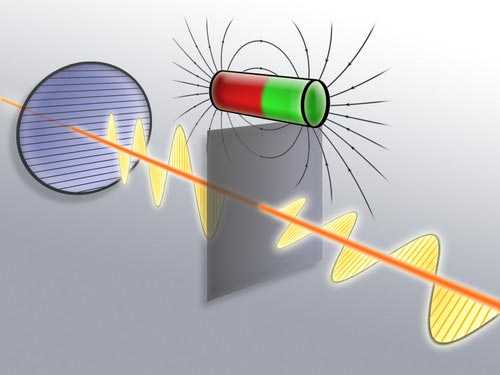
Physicists in Austria and Germany have taken the Faraday effect to a new extreme by rotating the polarization of light by 45° by passing it through an extremely thin film. This “giant Faraday effect” could someday be used to create optical transistors that switch light or to improve terahertz imaging systems.
Discovered in 1845 by Michael Faraday, the Faraday effect describes how a magnetic field shifts the polarization of light as the light passes through a medium. A material’s ability to rotate light is defined by its Verdet constant – the amount of rotation given per tesla of magnetic field strength and per metre of material. The previous record for the strongest Faraday effect was the semiconductor indium-antimony, which has a Verdet constant of about 104 radians per tesla per metre.
Now Andrei Pimenov and colleagues at the Vienna Institute of Technology in Austria and the University of Würzburg have shown that mercury-telluride has a Verdet constant of 106 radians per tesla per metre – which Pimenov described as “astonishing”.
A layered approach
To investigate mercury-telluride’s optical properties, the team layers the material over a thin piece of cadmium-telluride, which does not contribute to the Faraday rotation. Then linearly polarized light – with its electric-field electric component oscillating along a certain direction – is sent into the sample.
The oscillating electric field causes conduction electrons in the material to drift to and fro. When a magnetic field is applied to the material, the electrons assume circular orbits. These orbits affect the speed at which right and left circularly polarized light travels through the material. This has the effect of rotating the direction of polarization.
The researchers measured the effect by passing the emerging light through a polarizing filter – either aligned with the initial polarization or perpendicular to it. In the absence of the magnetic field, the aligned polarizer lets all the light through, while the perpendicular filter blocks it entirely. However, as the magnetic field is increased, less light comes through the aligned filter and more through the perpendicular filter. The proportion of transmitted light for each alignment told the researchers the degree to which the beam had turned.
‘Intriguing material’
For the film with a thickness of just 70 nm, the rotation reached a maximum of about 15° with a magnetic field of 1 tesla. However, a layer of mercury telluride 1 µm thick could rotate the light a little more than 45°. Sébastien Francoeur of École Polytechnique in Montreal called the semiconductor an “intriguing material” because electrons can travel relatively long distances without scattering and the electrons low effective mass – they behave as if they have just a 30th of their actual masses. Francoeur said these properties are “the special ingredients resulting in this giant magneto-optical effect”.
The effective mass of the electrons and the strength of the magnetic field help define the cyclotron frequency of the circular orbits. When the rotation of the light is greatest, the cyclotron frequency matches that of the light, suggesting that this resonance contributes to the giant Faraday effect.
To put the effect to use, the researchers suggest a transistor design for optical computing. “Using an external magnetic field, you can either switch on or switch off the transmission of the light,” says Pimenov. While an electronic transistor decides whether to let a current pass depending on the voltage applied to it, a mercury-telluride layer between two aligned linear polarizers would let light through when the magnetic field was off but not when it was on.
In order to make this device, the team would need to twist the light by 90° rather than just 45°. Pimenov says that multiple layers of mercury-telluride, separated by cadmium-telluride, should be able to rotate light by 360° or more.
One-way valves
With exactly 45° of rotation, the effect can also make for optical one-way valves. The light would pass through a linear polarizer and then be rotated by 45° on its way forward. If reflected, it would turn another 45° on its way back through the mercury-telluride. Now aligned perpendicular to the polarizer, it couldn’t pass.
The effect could also be used to perform terahertz imaging and spectroscopy in molecular biology, medicine, and security. According to Francoeur, terahertz light is “notoriously difficult to guide and it is challenging to manipulate its polarization state”. The giant Faraday effect in mercury-telluride makes a welcome addition to the toolbox.
The research is reported in Phys. Rev. Lett. 106 107404.



